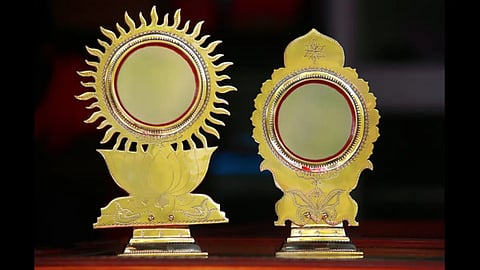
- Destinations
- Experiences
- Stay
- What's new
- Celebrating People
- Responsible Tourism
- CampaignsCampaigns
- SubscribeSubscribe
- Buy Now

A little over 100 km from Thiruvananthapuram, the capital of Kerala, is a small temple town called Aranmula. Located on the bank of the Pampa River, the town is frequented by Vaishnav pilgrims who come to visit the Parthasarathi (as Krishna was called when he acted as the charioteer of the Pandava brother Arjuna) Temple.
The town is also known for its annual boat race. But what most people are not aware of is that this place is also home to a dying craft—the Aranmula Kannadi or the Aranmula mirror—that was honoured with a Geographical Indication (GI) tag in 2005. The metallic mirror is an example of India's mastery over metallurgical techniques.
There are various stories associated with the origin of the Aranmula Kannadi. According to one popular tale, eight craftsmen from Tamil Nadu and their families were brought to work in the Parthasarathi temple. During the course of their work (some say as they were leaving for their homes in Tamil Nadu), the craftsmen presented a crown to the king that contained the mirror as part of the decoration.
Apparently, while working at the Parthasarathi Temple with different metals, the craftsmen had come upon a special alloy that had sharp reflective properties and doubled up as a mirror. Pleased with their metallurgical skills, the king invited them to stay back in Aranmula. Some of them did and continued to make the unique mirror. Although the alloy is known to be a mixture of copper and tin, the preparation is still a secret.
Magic In Metal
The mirror is considered auspicious and a symbol of good luck. It is part of the "astamangalya" or the eight auspicious objects displayed during religious and social functions, including New Year celebrations, marriages, etc.
Depending on the shape of the mirror, a mould is prepared. The craftsmen use a technique similar to the lost wax process. The metal is then polished. According to the craftsmen, making the mould and polishing is both a long and laborious task. Usually, they can make 70 to 80 mirrors from one single mould. The polishing may take several weeks to obtain the perfect finish. The mirror, set in an ornamental frame, is then ready to be sold.
Preserving the Past
However, artisans rue the lack of buyers of Kannadi and feel threatened by the competitive pricing offered by similar-sized glass mirrors. Therefore, many of the younger people are shunning the family profession and moving to higher-paying jobs. The Viswabrahmana Aranmula Metal Mirror Nirman Society, which was responsible for the mirror getting the GI tag, is trying to galvanise the craftsmen so that this traditional art form does not fade away.
Kerala Tourism has declared Aranmula a heritage village. It is known for its temples, including the Parthasarathy Temple. During the Vallasadya ritual, the presiding deity of Parthasarathy is offered over 70 kinds of specially prepared dishes. The oarsmen are also ritually treated to a grand feast on the day of the snake boat race. You may also enjoy Kerala's traditional music and dance programs here. The Kannadi shops are located around the main temple.
How to get there: Aranmula is nearly 120 km from Kerala's capital, Thiruvananthapuram, also the nearest airport. The nearest railway station Chengannur, is 11 km away.
